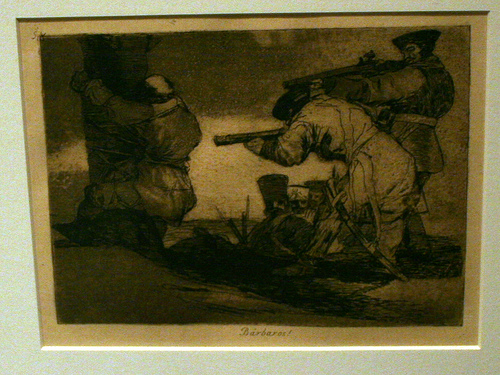By Paul Esau (The Cascade) – Email
Print Edition: February 8, 2012
For those of you who missed the January 25 issue of The Cascade, and thus News Editor Grace Romund’s excellent article on the subject, the Abbotsford Reach gallery is currently hosting an exhibit of works by the 19th century Spanish artist Francisco Goya y Lucientes. The exhibit, consisting mostly of a series of prints collectively entitled The Disasters of War, illustrates Goya’s recollection of the Peninsular War (1808-1814) between French, Spanish, and British forces. The title of the collection sums up the content of the 80 prints, which incorporate the memories of rapes, murders, atrocities, and corruption into the collective disasters of war.
I visited the gallery last Saturday, both to view the exhibit and to attend the accompanying Peace Symposium entitled “Conversations on War & Peace.” As a Mennonite and apprentice military historian (a contradiction if I’ve ever seen one), I was interested both in the content and the apparent oxymoron. The members of my ethnic community tend to dialogue about peace, the members of my academic community tend to analyze war, rarely are the two, in their mutual exclusivity, brought together.
Goya, the exhibit claimed, was one of the first artists to exchange the glorification of warfare for a portrayal of its destructive realities. His prints have ambiguous titles such as “I saw it (Yo Lo Vi)” or “This is bad (Esto es malo),” and depict hulking soldiers and weeping, diminutive civilians. The prints themselves are two centuries old, but the message is timeless. The Symposium, by contrast, addressed the complicated modern war, and its influence on our pursuit of an increasingly tangible peace.
The important message, for me, was that of Ernie Regehr, who made the controversial claim that war is not a “natural phenomena.” Regehr is co-founder of Project Ploughshares, an Ontario-based NGO with 30 years of advocacy for peace, reconciliation and justice. His assertions that “war is preventable,” and humanity is “not condemned to repeat patterns of destruction” are challenging ones, since society generally bemoans war as an evil, but accepts it as a reality. Homo Sapiens have, for the duration of their existence, waged increasingly disastrous wars, in what seems suspiciously like a repeating pattern of destruction. Regehr pointed out (controversially) that all 26 current wars occurring globally are civil rather than inter-state conflicts, implying this is progressive step. Perhaps, as Regehr concludes, the efficiency and potency of war machines, coupled with a more dynamic and responsible international community, is making warfare increasingly difficult–but will it end? Will there come a time when we can look at Goya’s works with a clean conscience and see them only as historical relics?
There is a significant tradition in the West which saw and continues to see the Atom Bomb as the beginning of the end of armed conflict. The assumption was that the risks were simply too great, that world leaders would eventually see reason and give up the idea of ever returning to the battlefield. Intrinsic to this hope was an equal fear that those leaders would not see reason, and the world as we know it, would come to an end.
Alexei Summers has a compelling piece on the contemporary consequences of this “Cold War mentality” this week on page 7, yet I had my own experience with apocalyptic fear last week in the anecdotes of former Canadian Reserves member and UFV staff Michael Van Drunen. I pondered Michael’s experience of the Cold War throughout Regehr’s presentation, trying to reconcile Regehr’s notion of an improving global stability with Mike’s story.
As a resident of Regina, Saskatchewan, Mike experienced a time and a mentality inscrutable to those of us born in the 1990s. “We were all convinced that nuclear bombs were going to drop sooner or later,” he related, adding that, after they’d taken a tour of the American missile silos only minutes south of the border in Montana, he and his friends realized they were right in the “target zone.” Deprived of protective suits, Mike and his peers were issued iodine pills to counter any potential radioactive fallout in the coming war, a war in which Canada was supposed to be the primary battleground.
It is hard sometimes to hope that wars are illogical, preventable, ultimately unnatural, when people like Mike can remember believing they were in danger of annihilation in the recent past. It is even harder when one sees the natural transformation from fear into violence. “We all knew we would be dead,” Mike said, “we always talked about it openly…. We had all kinds of horrible war chants…. We were going to be terrifying to anybody that came in front of us…. My biggest fear was that I wouldn’t be able to get a shot off at one of these commie buggers. I wanted to at least dust one off before I bought it.”
Mike regrets his belligerence, but says it was natural of the times. “Somebody once said that radioactivity is better than no activity,” he quipped, an expression similar to the infamous ‘better dead than red’.
Even so, I found myself wanting to believe in Regehr and his understanding of the artificial nature of war. I hope that he is right, that humanity’s collective wisdom can overcome its fear, and that Isaiah 2:4, the verse after which Project Ploughshares is titled, can someday describe our world:
“God shall judge between the nations, and shall decide for many peoples; and they shall beat their swords into ploughshares, and spears into pruning hooks; nation shall not lift up sword against nation; neither shall they learn war any more.”


